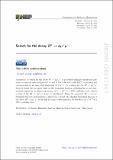| dc.contributor.author | Aaij, R. | |
| dc.contributor.author | Abdelmotteleb, A. S. W. | |
| dc.contributor.author | Abellán Beteta, C. | |
| dc.contributor.author | Abudinén, F. | |
| dc.contributor.author | Ackernley, T. | |
| dc.contributor.author | Adeva, B. | |
| dc.contributor.author | Adinolfi, M. | |
| dc.contributor.author | Afsharnia, H. | |
| dc.contributor.author | Agapopoulou, C. | |
| dc.contributor.author | Aidala, C. A. | |
| dc.contributor.author | Aiola, S. | |
| dc.contributor.author | Ajaltouni, Z. | |
| dc.contributor.author | Akar, S. | |
| dc.contributor.author | Albrecht, J. | |
| dc.contributor.author | Alessio, F. | |
| dc.contributor.author | Alexander, M. | |
| dc.date.accessioned | 2022-05-16T16:17:47Z | |
| dc.date.available | 2022-05-16T16:17:47Z | |
| dc.date.issued | 2022-05-11 | |
| dc.identifier.uri | https://hdl.handle.net/1721.1/142546 | |
| dc.description.abstract | Abstract
A search for the decay B0 → ϕμ+μ− is performed using proton-proton collisions at centre-of-mass energies of 7, 8, and 13 TeV collected by the LHCb experiment and corresponding to an integrated luminosity of 9 fb−1. No evidence for the B0 → ϕμ+μ− decay is found and an upper limit on the branching fraction, excluding the ϕ and charmonium regions in the dimuon spectrum, of 4.4 × 10−3 at a 90% credibility level, relative to that of the
B
s
0
$$ {B}_s^0 $$
→ ϕμ+μ− decay, is established. Using the measured
B
s
0
$$ {B}_s^0 $$
→ ϕμ+μ− branching fraction and assuming a phase-space model, the absolute branching fraction of the decay B0 → ϕμ+μ− in the full q2 range is determined to be less than 3.2 × 10−9 at a 90% credibility level. | en_US |
| dc.publisher | Springer Berlin Heidelberg | en_US |
| dc.relation.isversionof | https://doi.org/10.1007/JHEP05(2022)067 | en_US |
| dc.rights | Creative Commons Attribution | en_US |
| dc.rights.uri | https://creativecommons.org/licenses/by/4.0 | en_US |
| dc.source | Springer Berlin Heidelberg | en_US |
| dc.title | Search for the decay B0 → ϕμ+μ− | en_US |
| dc.type | Article | en_US |
| dc.identifier.citation | Journal of High Energy Physics. 2022 May 11;2022(5):67 | en_US |
| dc.contributor.department | Massachusetts Institute of Technology. Department of Physics | |
| dc.identifier.mitlicense | PUBLISHER_CC | |
| dc.eprint.version | Final published version | en_US |
| dc.type.uri | http://purl.org/eprint/type/JournalArticle | en_US |
| eprint.status | http://purl.org/eprint/status/PeerReviewed | en_US |
| dc.date.updated | 2022-05-15T04:22:52Z | |
| dc.language.rfc3066 | en | |
| dc.rights.holder | The Author(s) | |
| dspace.embargo.terms | N | |
| dspace.date.submission | 2022-05-15T04:22:52Z | |
| mit.license | PUBLISHER_CC | |
| mit.metadata.status | Authority Work and Publication Information Needed | en_US |
